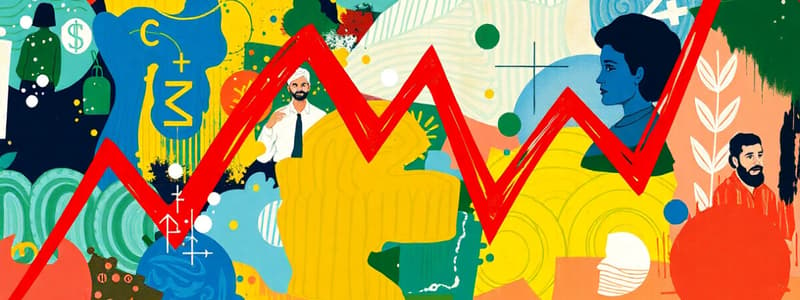Podcast
Questions and Answers
What happens to the demand for a currency when a country exports more than it imports?
What happens to the demand for a currency when a country exports more than it imports?
- The demand for the currency decreases, leading to no change.
- The demand for the currency decreases, leading to appreciation.
- The demand for the currency increases, leading to appreciation. (correct)
- The demand for the currency increases, leading to depreciation.
How does a currency depreciation affect export prices for foreign consumers?
How does a currency depreciation affect export prices for foreign consumers?
- Exports become more expensive.
- Exports are only affected in domestic markets.
- Exports become cheaper. (correct)
- Export prices remain unchanged.
Which of the following occurs in a surplus country with an appreciation of its currency?
Which of the following occurs in a surplus country with an appreciation of its currency?
- Imports become cheaper, increasing their demand.
- Exports become more expensive, decreasing their demand. (correct)
- Imports become more expensive, decreasing their demand.
- Exports become cheaper, increasing their demand.
What is the immediate effect of excessive demand for a currency in a floating exchange rate system?
What is the immediate effect of excessive demand for a currency in a floating exchange rate system?
When a country has a balance of payments deficit, what typically occurs in terms of its currency's value?
When a country has a balance of payments deficit, what typically occurs in terms of its currency's value?
How does the appreciation of a currency impact domestic consumers' demand for imports?
How does the appreciation of a currency impact domestic consumers' demand for imports?
In the context of floating exchange rates, how is monetary policy likely to influence currency value during a surplus?
In the context of floating exchange rates, how is monetary policy likely to influence currency value during a surplus?
What is the primary mechanism through which balance of payments adjustments occur in floating exchange rate systems?
What is the primary mechanism through which balance of payments adjustments occur in floating exchange rate systems?
Under fixed exchange rate systems, which method is NOT used by governments to maintain the fixed rate?
Under fixed exchange rate systems, which method is NOT used by governments to maintain the fixed rate?
What is a crucial benefit of floating exchange rate systems regarding government policy?
What is a crucial benefit of floating exchange rate systems regarding government policy?
Which of the following actions can a government take to address a balance of payments surplus in a fixed exchange rate system?
Which of the following actions can a government take to address a balance of payments surplus in a fixed exchange rate system?
What impact do capital controls have on balance of payments adjustments?
What impact do capital controls have on balance of payments adjustments?
What best describes a Fixed-but-Adjustable exchange rate regime?
What best describes a Fixed-but-Adjustable exchange rate regime?
How does a Floating exchange rate regime primarily adjust the Balance of Payments?
How does a Floating exchange rate regime primarily adjust the Balance of Payments?
Which account records non-financial transactions in the Balance of Payments?
Which account records non-financial transactions in the Balance of Payments?
What is a key characteristic of a Managed Float exchange rate regime?
What is a key characteristic of a Managed Float exchange rate regime?
What could result from a persistent imbalance in a country’s Balance of Payments?
What could result from a persistent imbalance in a country’s Balance of Payments?
Which of the following is NOT a factor typically recorded in the Current Account?
Which of the following is NOT a factor typically recorded in the Current Account?
What mechanism primarily governs the adjustment of the Balance of Payments in a Fixed exchange rate regime?
What mechanism primarily governs the adjustment of the Balance of Payments in a Fixed exchange rate regime?
Which statement about capital controls is accurate?
Which statement about capital controls is accurate?
Which is a result of the Unholy Trinity/Trilemma in international economics?
Which is a result of the Unholy Trinity/Trilemma in international economics?
In which scenario would an economy most likely adopt a Managed Float exchange rate regime?
In which scenario would an economy most likely adopt a Managed Float exchange rate regime?
Flashcards
Export impact on currency
Export impact on currency
When a country exports more than it imports, the demand for its currency increases, putting upward pressure on its exchange rate.
Import impact on currency
Import impact on currency
When a country imports more than it exports, the supply of its currency increases, putting downward pressure on its exchange rate.
Currency Appreciation
Currency Appreciation
An increase in the value of a currency relative to other currencies.
Currency Depreciation
Currency Depreciation
Signup and view all the flashcards
Currency Appreciation and Exports
Currency Appreciation and Exports
Signup and view all the flashcards
Currency Depreciation and Imports
Currency Depreciation and Imports
Signup and view all the flashcards
Floating Exchange Rate Adjustment
Floating Exchange Rate Adjustment
Signup and view all the flashcards
Exchange Rate Regimes
Exchange Rate Regimes
Signup and view all the flashcards
Fixed Exchange Rate
Fixed Exchange Rate
Signup and view all the flashcards
Floating Exchange Rate
Floating Exchange Rate
Signup and view all the flashcards
Fixed-but-Adjustable Exchange Rate
Fixed-but-Adjustable Exchange Rate
Signup and view all the flashcards
Managed Float Exchange Rate
Managed Float Exchange Rate
Signup and view all the flashcards
Balance of Payments
Balance of Payments
Signup and view all the flashcards
Current Account
Current Account
Signup and view all the flashcards
Capital and Financial Accounts
Capital and Financial Accounts
Signup and view all the flashcards
Balance of Payments Adjustment
Balance of Payments Adjustment
Signup and view all the flashcards
Imports/Exports
Imports/Exports
Signup and view all the flashcards
BoP Adjustment (Floating XR)
BoP Adjustment (Floating XR)
Signup and view all the flashcards
Fixed Exchange Rate Adjustment
Fixed Exchange Rate Adjustment
Signup and view all the flashcards
Currency Intervention (Fixed XR)
Currency Intervention (Fixed XR)
Signup and view all the flashcards
Interest Rate Adjustment (Fixed XR)
Interest Rate Adjustment (Fixed XR)
Signup and view all the flashcards
Capital Controls (Fixed XR)
Capital Controls (Fixed XR)
Signup and view all the flashcards
Study Notes
Foundations of Monetary and Exchange Rate Policy
- The lecture covers the foundations of monetary and exchange rate policy.
- Money serves three main functions: a medium of exchange, a store of value, and a unit of account.
- A medium of exchange solves the "double coincidence of wants problem."
- A store of value allows for converting perishable goods into more durable goods.
- A unit of account provides a standard relationship between goods in the economy.
- Currency is a public good, benefiting everyone, but its creation and maintenance face collective action problems.
- Money, like other goods, responds to supply and demand. Supply up, value down; supply down, value up; demand up, value up; demand down, value down.
- Exchange rates reflect the relative value of currencies. Appreciation means a gain in value, and depreciation means a loss in value.
- Domestic monetary policy adjusts money supply to influence inflation and economic output.
- The ECB is responsible for monetary policy in Europe.
- The central bank influences economic conditions using interest rates and money supply.
- The Phillips Curve illustrates the trade-off between inflation and unemployment.
- International monetary exchange facilitates trade and investment between nations.
- The balance of payments tracks the flow of money into and out of a country. The current account records current transactions, and the capital/financial account tracks financial flows.
- Exchange rate regimes (fixed, floating, fixed-but-adjustable, managed float) dictate how a country's exchange rate moves.
The Function of Money
- A currency is a public good, benefiting everyone.
- It's both non-rival (consumption by one person does not reduce availability to others) and non-excludable (difficult to prevent people from benefiting from it).
- Public goods often face collective action problems, both internationally and domestically.
The Plan
- What is Money (and an exchange rate regime) Good For?
- Domestic Monetary Policy
- International Monetary Exchange
- Balance of Payments Adjustment
- The Unholy Trinity
Exchange Rate Regimes
- Exchange rate regimes govern currency appreciation and depreciation.
- Different regimes include:
- Fixed
- Floating
- Fixed-but-adjustable
- Managed float
Balance of Payments
- The balance of Payments (BoP) shows the difference between money entering and leaving a country.
- The current account tracks current transactions (imports/exports, services, etc.).
- The capital and financial accounts track financial flows.
The Unholy Trinity/Trilemma
- States face a dilemma when choosing between fixed exchange rates, monetary policy autonomy, and free capital flow.
- They can only maintain two of these three simultaneously.
Changes in Interest Rates
- Changes in interest rates can affect exchange rates, particularly for domestic and international investors.
Capital Controls
- Capital controls constrain financial transactions between countries to potentially stabilize exchange rates.
Summary Balance of Payments Adjustment
- Fixed exchange rates make trade easier, but prices adjust within countries.
- Floating exchange rates make trade harder, but prices are stable within countries.
What to Know Well:
- XR regimes affect how states manage balance of payments and domestic/international price levels.
- Exchange rate regimes impact how countries adjust to BoP surpluses or deficits.
- The Unholy Trinity/Trilemma is the policy dilemma central banks face when managing their currency.
Monetary Policy
- Central banks use monetary policy to influence interest rates and money supply to boost the domestic economy.
- Higher money supply makes the currency less valuable on international markets.
- Lower interest rates make investment less attractive.
Studying That Suits You
Use AI to generate personalized quizzes and flashcards to suit your learning preferences.
Related Documents
Description
This quiz explores the fundamental concepts of monetary and exchange rate policies. It covers the functions of money, the dynamics of supply and demand, and the role of exchange rates in economic contexts. Participants will deepen their understanding of how these elements influence inflation and economic stability.




